A city can plan for people, patios, jobs, commerce and vibrant neighbourhoods, or else plan for speeding cars and window mattresses.
By Jason Leach
Published March 21, 2016
I was in Toronto on Sunday and as always, I enjoyed the time spent in an urban environment that has been nurtured to enhance the quality of life, economy and business success of its downtown area neighbourhoods.
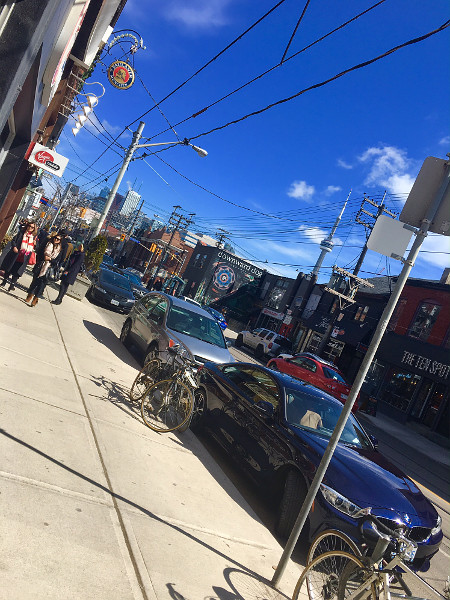
Street life in Toronto
Most of my time was spent in the Queen West area from Bathurst over to Ossington. I walked on main streets, parks and side streets and couldn't help but be envious of the tremendous quality of life that residents in these neighbourhoods enjoy.
Not once did I feel in danger crossing a street during my walk.
The sidewalks, cafes and parks were absolutely overflowing with families, dog walkers, exercisers and everyone from teens to elderly out enjoying the sun despite a chilly breeze blowing off the lake keeping the temperature around 3 degrees.
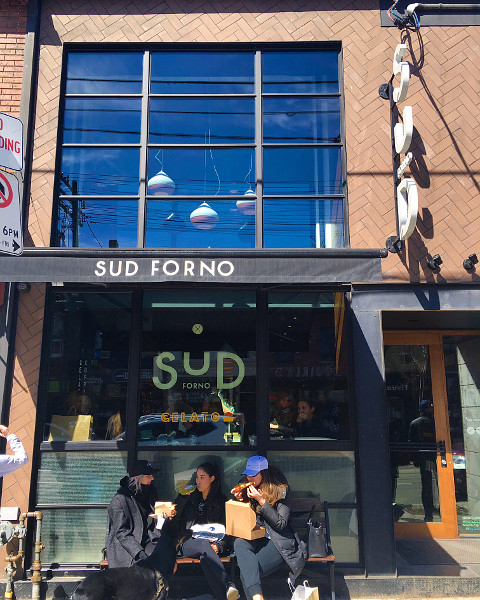
Businesses overflowing with people
I was very pleased to see an ice cream shop with beautiful side patio on Shaw Street. It was the only business with low rise residential uses on all streets in every direction.
At 3 degrees, the patio was in good use yesterday and families enjoyed a bite to eat and an ice cream. In fact, every patio I walked by yesterday was full of people enjoying the sunshine.
I recall an ice cream shop proposal at Locke and Peter in Hamilton that was supported by the neighbourhood and city councillor, but rejected by staff because it was in the middle of the neighbourhood, even though it would be in a building that had already been a commercial storefront for decades.
That wonderful location next to Victoria Park was converted to 'residential' by our city planners, shutting the door to any future business ventures, and has since sat empty with mattresses in the windows for the last three years.
I didn't see a single side street in Toronto with a 50 km/h speed limit. All were 30 km/h and most had speed humps.
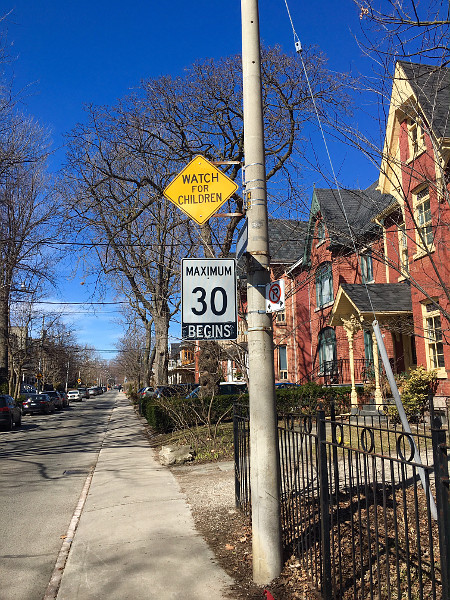
30 km/h speed limit
Even the previously four-lane Shaw Street is now one lane each way with curb parking, speed humps, bike symbols in the middle of the road and a low speed limit.
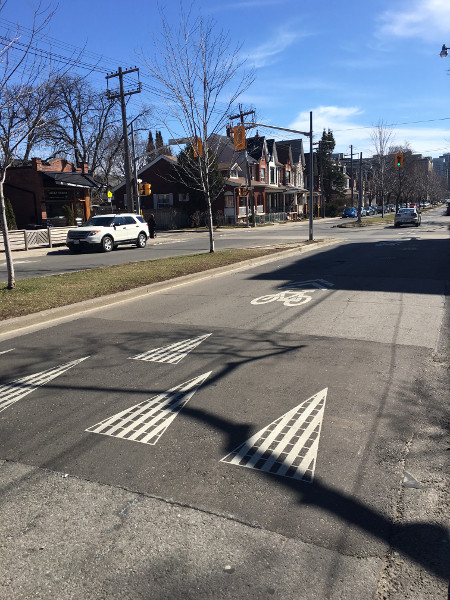
Shaw Street
And another previously wide one-way street in Toronto now had a contraflow bike lane which was heavily used when I was there.
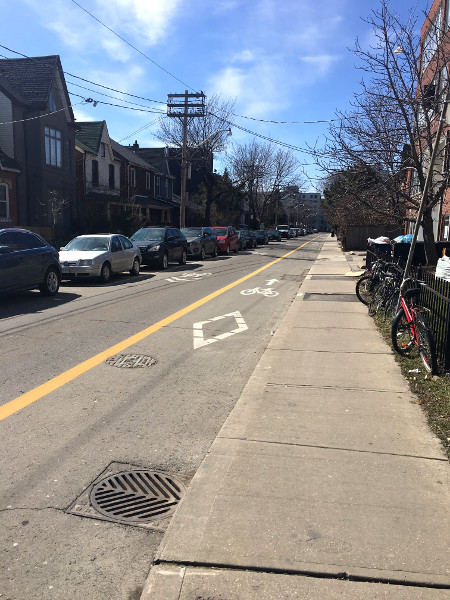
Contraflow bike lane
As other cities around the world have taught us, lower speed limit signs aren't enough. Physical changes must be made so that the new speed limit can't be easily exceeded.
Hamilton should roll out 30 km/h speed limits on all side streets, with 40 km/h the new standard on main streets. I regularly drive on Wilson Street, and it's amazing how much safer the stretch near Dr Davey School is with the new 40 km/h speed limit. On a main street like that, 40 seems to slow things down just enough to allow better observation of kids walking or biking to school.
This past winter there were a few snowy days where my drive home on Cannon didn't exceed 40 km/h. I started timing the trip and realized that from Sherman to Queen, doing 40 the entire way didn't add any time onto the length of my trip. There is simply no reason for us to maintain 50 or 60 km/h speed limits when we see the impacts on the fatality rate.
A recent Hamilton Spectator article highlighted the massive demand from Hamilton residents asking for neighbourhood traffic calming here as we finally start to realize that high speed, single-occupancy car traffic has greatly diminished our quality of life, safety and neighbourhood vibrancy.
Last year, the city cut the speed limit from 50 km/h — the default unsigned maximum — to 40 km/h on 250 residential streets, often around schools but also by neighbourhood request. Just a few years ago, only "a handful" of such changes would be made per year, said traffic operations manager Martin White.
Last year also saw more speed humps and "knock-down" sticks installed, as well as 103 "ladder" crossings added to intersections — more pedestrian-friendly paint jobs than in the previous two years combined.
All that work only took care of about a third of the 900 resident requests for traffic safety changes in 2015, triple the average in years past.
Interestingly, I came home from TOronto and, while walking on King West near Locke, snapped a photo that does a perfect job at highlighting the two different styles of city-building.
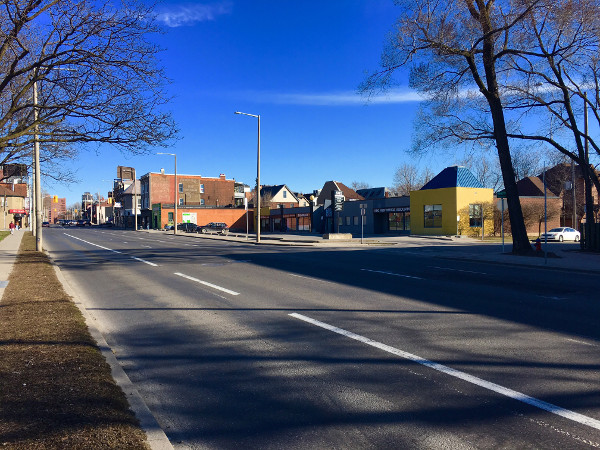
King Street West near Locke
A city can be business-friendly, safe, vibrant and an enjoyable place to hang out, or it can be an empty speeding freeway. Our planning choices and budgets show our priorities.
It is interesting to note that these neighbourhoods were built in a similar era. Queen and Bathurst is 2.2 km from Queen and Yonge. King and Locke is 1.2 km from King and James. Yet they might as well be on different planets now.
Is it any surprise that Hamilton has significantly fewer jobs per worker than Toronto?
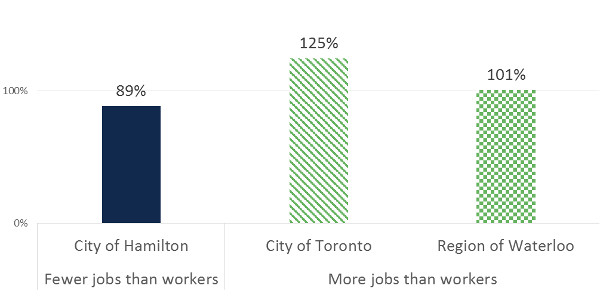
Chart: jobs per worker in Hamilton, Toronto and Waterloo
I would love to see a tally of all the jobs in action in the Queen/Bathurst/Ossington neighbourhoods, compared with King Street between Queen and Dundurn in Hamilton.
With LRT coming, we have a huge opportunity to rebalance our streets and set our neighbourhoods up for prosperity, if we can muster the vision and courage to stand up to the squelchers who only care about driving as fast as possible through the city.
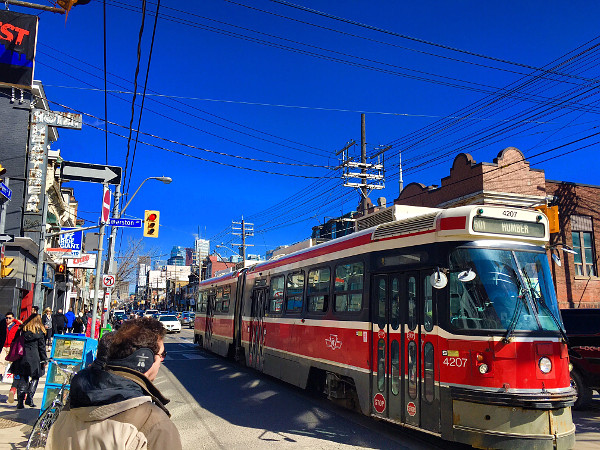
Streetcar on Queen Street in Toronto
It is very simple. You get the city - and the economy - you plan for.
Plan for people, patios, jobs, commerce and vibrant neighbourhoods, or plan for speeding cars and window mattresses.
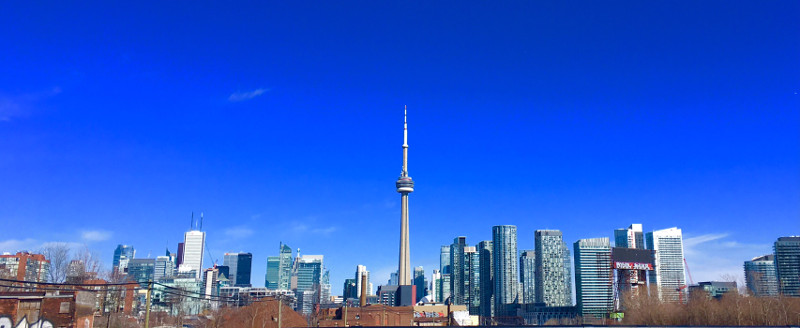
Toronto skyline
By stone (registered) | Posted March 21, 2016 at 11:57:26
Queen and Bathurst in the 90's was wretched and Ossington was a street you went to if you wanted to get stabbed, both are pretty nice now. Hamilton needs the density if it wants it neighbourhoods to get better but it's well on it's way. The idea that the best part of Hamilton is the Lower City has already taken hold, even five years ago no one would have thought that would ever happen.
By KevinLove (registered) | Posted March 21, 2016 at 19:35:21 in reply to Comment 117085
It is not necessary to have high density to create a pleasant, liveable urban space. Here is a video from the rather low-density town of Assen in The Netherlands. Notice its before-and-after from the 1970's to today. The lesson is that Hamilton does not have to be stuck in the 1970's. They changed. We can too. See:
By JasonL (registered) | Posted March 21, 2016 at 12:06:44 in reply to Comment 117085
Agreed on the mindset shift regarding our lower city. It's the same mindset shift that has happened everywhere, including Toronto. However, I don't necessarily agree that our density isn't enough to support walkable, vibrant neighbourhood streets. Sure, we need more density to continue supporting local business, but look at Locke and James.
We could take all the new towers in Mississauga with their 10's of thousands of people and plop them on King West and it would still be a horrid place to sit and enjoy city life.
As the above pics show, the residential fabric off the main streets in this part of Toronto is similar to ours. Heck, look at the residential neighbourhoods surrounding downtown Dundas. Lower density than many hoods in Hamilton, yet the area is designed to be walkable, and therefore booms.
Walkability is directly tied to design. We need to change our design, especially now that as you've pointed out, people actually want to live in these neighbourhoods.
Comment edited by JasonL on 2016-03-21 12:08:33
By RobF (registered) | Posted March 22, 2016 at 13:36:05 in reply to Comment 117086
There is compact built form and then there is density. The two are linked, but not as tightly as most people think. The "old" city of Toronto has added a lot of housing units since the 1970s, but not a lot of actual people. In fact, until the 2011 census, in which the impact waterfront condo boom finally registered, the old city had yet to surpass its postwar high in terms of population (just over 700k).
We also need to disconnect the notion of "revitalization" or walkable, vibrant neighbourhood streets from density. Built-form or urban design matters, but a wide range of densities can be walkable, vibrant, and transit-supportive. Toronto has lots of high-density suburban neighbourhoods that aren't walkable and aren't likely to become so.
Finally "revitalization" is normally accompanied by population decline (if we are really talking about gentrification), not increases (except where brownfield regeneration takes place). The pattern is generally de-conversions of rental units in low-rise housing stock and a general fall in household sizes.
Retail analysts will tell you its not about density of people, but density of money. What matters in terms of the resurgence of urban street retail districts is trade area improvement ... i.e. increased disposable income and a consumer preference to spend more of it at independent shops rather than at shopping centres and supermarkets. It's lifestyle preference not density that fuels café culture, foodie restaurants, artisan shops, and so on.
Comment edited by RobF on 2016-03-22 13:40:34
By MattM (registered) | Posted March 21, 2016 at 19:33:35 in reply to Comment 117089
pretty sure I've never seen an ambulance speeding down a residential side street at anything over 30-40km/h. Your post is ridiculous.
By AnjoMan (registered) | Posted March 21, 2016 at 15:34:33 in reply to Comment 117089
Speed bumps are a rounding error on all the factors that could make the difference between life and death for an emergency call --- yet you choose that over the well quantified increases in quality-of-life and reductions in mortality associated with slower traffic speeds. How anout, "my neighbours life isbas important as that of my loved one".
By z jones (registered) | Posted March 21, 2016 at 14:07:38 in reply to Comment 117089
I hope they put speed bumps on your street and your loved one doesn't need to be rushed to a hospital because they didn't get hit by a speeding car.
There, I fixed your sick, sick wish that someone's child gets hurt to make a bullshit point about you not wanting to have to slow down.
By Vroom Vroom (anonymous) | Posted March 21, 2016 at 14:06:23 in reply to Comment 117089
That's why I am hoping my loved ones are on a 400 series highway when they need an ambulance. Speed baby speed!
By highasageorgiapine (registered) | Posted March 21, 2016 at 13:36:17 in reply to Comment 117089
this is quite possibly the weirdest comment ever. speed bumps really do not impact emergency response time or transport time.
By stone (registered) | Posted March 21, 2016 at 13:45:51 in reply to Comment 117090
Simply put. Speedbumps make it hard to speed down a side street so they are a bad idea.
Is what that comment was really saying.
By Main (anonymous) | Posted March 21, 2016 at 13:43:30
As much as I agree wth this article, the story has become a broken record.
15 years after being approved
9 years of successful test streets (John & James)
Still no action, just reassurances it will happen one day.
I'm tired of reading this article (whether it's Toronto, Portland or Montreal), I want to see results!
By DowntownInHamilton (registered) | Posted March 21, 2016 at 21:29:26 in reply to Comment 117091
9 years of successful test streets (John & James)
Please show the success of John South since the 2 way conversion.
By JasonL (registered) | Posted March 21, 2016 at 21:43:24 in reply to Comment 117109
Walk King to Young and check it out.
By DowntownInHamilton (registered) | Posted March 22, 2016 at 19:04:37 in reply to Comment 117111
I used to, weekly, when I lived at John and Charlton. The stretch from Main to Charlton has yet to see any sort of economic impact, aside from a couple of hipster places that couldn't afford to be on James North.
By z jones (registered) | Posted March 22, 2016 at 19:38:56 in reply to Comment 117158
You're hilarious!
By DowntownInHamilton (registered) | Posted March 25, 2016 at 06:19:38 in reply to Comment 117166
By I have cycled and walked it (anonymous) | Posted March 22, 2016 at 11:29:23 in reply to Comment 117111
By highasageorgiapine (registered) | Posted March 21, 2016 at 16:36:42 in reply to Comment 117091
i can empathize with this statement.
i don't think it's helpful to paint all of toronto as some sort of planning mecca. in these affluent neighbourhoods that people like to visit, yes, things are quite nice! you could make this same article with some neighbourhoods in hamilton and make it seem like a progressive place also when in reality neither are great overall examples. for most people who live in the city, their experience isn't so pleasant.
that being said this article outlines some good ideas to consider. the speed limit reduction would be great from a public health perspective. given my above comment, it would be useful to remind people that when the medical officer of health proposed a blanket reduction of speed in toronto he was publicly shamed by the mayor. i highly doubt this would even be seriously considered here
By JasonL (registered) | Posted March 21, 2016 at 20:40:42 in reply to Comment 117100
just to clarify one thing, I don't think this is considered an 'affluent' neighbourhood.
Yes, I've seen all these same speed limits and safe street designs around High Park and in the Beaches, but this is a downtown hood full of triplexes and rentals. Have a look:
Comment edited by JasonL on 2016-03-21 20:41:10
By stone (registered) | Posted March 21, 2016 at 13:49:47
I would say there are results everywhere, it's just that Main and King stick out like sore thumbs. It's like building a 5000 piece jigsaw puzzle, you know what the finished result will be, it just takes forever to put all the pieces together.
By Bobbobbob (anonymous) | Posted March 21, 2016 at 20:20:50
Don't take my word for it:
Read ambulances and speed bumps (from an ambulance chief) much more qualified than me:
dailymail.co.uk/news/article-156971/Speed-humps-threat-lives-says-ambulance-chief
By Haveacow (registered) | Posted March 22, 2016 at 10:16:58 in reply to Comment 117105
One of my brother's in law is a paramedic and has been one for almost 23 years. Yes, more of them are around because of PROVINCIAL REQUIREMENTS (not local requirements) for on time arrival. Most of the increase is due to a requirement that was passed down in 2002. At that time, many of the paramedic services in Ontario were in crisis, it didn't matter whether it was part of the provincial service or a municipal one, many operations were losing too many paramedics due to on the job stress. It was found that, there just wasn't enough of them anywhere. Double even triple shifts were becoming far too common and it didn't matter how much they were paid. So the province, very quietly, set up a program with the goal of tripling or quadrupling the number of available paramedic spaces, province wide. It is has taken almost 14 years but they got to almost double the number of paramedics they had in 2000. They are still having retention issues with paramedics, due to high levels of on the job stress and cases of PTSD, which are still increasing for paramedics. It had nothing to do with traffic calming or speed bumps why a person doesn't survive to make it to the hospital. As my brother in law will say, Its paramedic staffing issues, numbers and equipment issues that most often determine non medical related DOA deaths at hospitals.
There is one very stark and often a very sad reason people don't survive, if a person stops breathing as my brother in law often says, "you have 3-3.5 minutes before its really too late, not 5 minutes" (brain damage begins at this point). There is no road wide enough, fast enough that will get you to a patient's house or to a hospital on time to make a difference with that. This is under the assumption that, someone is around when the patient actually stops breathing and can even do anything about it. The time it takes to realize someone is not breathing and have that person calls 911, is often the main reason why someone survives or not. It has nothing to do with the road. Talk to my brother in law when you have a transporter from Star Trek, then you will have something that will save most but not all of the DOA's at hospitals.
By notlloyd (registered) - website | Posted March 21, 2016 at 20:55:06 in reply to Comment 117105
The article says they have had to increase ambulance staffing by 65% as a result of traffic calming. Further from the article:
Meanwhile a reduction of one minute on average response times could save up to 500 more lives a year, he said.
Mr Reinton said: "We have made tremendous improvements in recent years, and in November achieved the Government's standard of reaching 75% of Category A calls in eight minutes.
"But I am convinced that we could save even more lives if the traffic was flowing better.
"The situation is about more than just road humps - our ambulances also have to slow down for chicanes and width barriers, often to just walking pace.
"The fact that side streets have been shut off also has an impact as we then get caught up in the increased traffic on other routes."
One has to wonder what will happen when King is two way and the ambulances can't turn left. For a site that screams over one death more per year for pedestrians between Hamilton and Ottawa, I wonder if there would be the same screaming over this.
Not really choosing safety and livability over speeding trafic - choosing "livability" over safety and expense/cost more likely.
Comment edited by notlloyd on 2016-03-21 21:04:52
By seancb (registered) - website | Posted March 22, 2016 at 08:28:48 in reply to Comment 117107
Ambulances can go through intersections at red lights, can weave into oncoming lanes when clear, and cars have to pull over to make space. But they can not go full bore the wrong way down one way streets. Two way reversions will improve emergency vehicle access, not restrict it.
By DowntownInHamilton (registered) | Posted March 21, 2016 at 21:32:18 in reply to Comment 117107
One has to wonder what will happen when King is two way
You can wonder all day long, but it won't happen in your lifetime, or anyone's!
By JasonL (registered) | Posted March 21, 2016 at 21:44:08 in reply to Comment 117110
depends on how long it takes us to de-amalgamate
By DowntownInHamilton (registered) | Posted March 22, 2016 at 19:06:14 in reply to Comment 117112
Again, that won't happen in anyone's lifetime so give it up.
By JasonL (registered) | Posted March 21, 2016 at 21:21:36 in reply to Comment 117107
Seems like ambulances function fine along York Blvd only being allowed to turn left at signalized intersections. Ditto for University Ave in Toronto or Shaw etc.....
If anything, being able to go 2-way on King and Main will save them TONS of time not having to around in circles on useless one-way pairs.
By CharlesBall (registered) | Posted March 22, 2016 at 09:34:10
I used to live in Leaside and worked in downtown Toronto. I avoid the city now (I want to say like the plague but that is too harsh.) Traffic congestion being the second worst in Canada, top 5 in north America and 64th worst in the world make it an undesirable destination for me. When I have to go there for work I take the train and keep to the downtown and then come back. Anywhere else where driving is required is uber frustrating. It may be a great place for people living in the various areas that they do, but the road networks do not encourage visitation.
I read today that Tomtom says that Torontonians travel times are 28% above what they should be.
Any time that I spend in a car, bus, train or plane longer than I have to is wasted time. Livability to me means spending my time on things I like to do, not trudging along because someone purposely is setting up figurative and literal roadblocks. (Roadblocks have always had a negative connotation in literature.)
I still have many friends in Toronto and they love their city, but transit is their number one complaint.
By JasonL (registered) | Posted March 22, 2016 at 09:43:18 in reply to Comment 117118
certainly there is another whole discussion to be had regarding the poor transit investment in Toronto in recent decades. That lesson should be a warning to us in little Hamilton to get our transit in tip top shape before we become too far behind.
I think that makes Toronto's continued investment in safe streets even more commendable, since they face much greater pressure from car drivers to 'speed things up a little'.
They won't allow businesses on Queen, King, College etc... to suffer just so they can open up 4-5 lane one way expressways for car drivers.
Kudos to them for having a vision of a successful, business-friendly city.
Hopefully they'll improve their transit to ease the burden of travel in that city.
This also highlights how embarrassing Hamilton is. We have zero congestion, yet still have elected officials trying to speed up car travel at the expense of all other transportation modes.
I must, however, take exception to the term 'roadblock'. I don't recall anyone suggesting we literally close off all roads and make people walk.
We're talking about not allowing people to do 100+ down King and slice humans in half, or roar 70 down quiet side streets next to parks and schools. Some of the worlds most livable cities have 20 or 30km speed limits on side streets and 40km on main streets. That's not a 'roadblock', its' a safe speed to drive a 2 ton hunk of metal with people, cyclists, kids and shop-goers all mixing together.
Comment edited by JasonL on 2016-03-22 09:47:41
By Haveacow (registered) | Posted March 22, 2016 at 13:03:49
More Tomtom crap! If there is one thing traffic engineers and urban planners the continent over agree on (the ones not being paid by Tomtom), using these Tomtom studies as a measure for anything accurate other than the sale of Tomtom units, is mostly useless. Their studies might be useful if your are using it with other collected data, inside an isolated area or series of areas inside a city. But if you look at their very flawed study methodology, a methodology that most first and second year students studying these subjects at university can easily spot as a problem, it is a piss poor way to compare anything as complex as traffic levels between large city wide metropolitan regions. All while trying to break all this complexity down to a simple string of numbers, and have the data actually mean anything. This is why the media (bloggers included) love it and continue to use it, its simple. Is it actually accurate in anyway? Especially when comparing whole regions, no! The reason is why a study like this is rarely done is that, for any kind of study like this to be really accurate, it would be expensive, incredibly complex, very time consuming (it would take years to just set down all the measures of what you want) and would not lend it self to simple string of numbers when it was done.
There are literally hundreds of different measures involved and how each traffic network link functions (its network role) in each of the cities being chosen to be measured. Assuming you can breakdown all the traffic data from all these cities exactly the same way. Texas has something like this for just its state highways and expressways and boy its involved, complex and is not for anyone interested in a easy quick read. It's methodology is really a ever growing complex system and is has to be done by a large research team at several Texas universities, as group project. If you if you want a copy of their latest information its available, but not for free!
By Haveacow (registered) | Posted March 22, 2016 at 13:22:56
Tomtom says that, Torontonians travel times are 28% above what they should be. Really, 28% above what and compared to what? Toronto and the Greater Golden Horseshoe Planning Area (the official commuter region of Toronto) was created and defined by provincial law in 2006. It has a core city (City of Toronto) with a population of 2.8 Million and a regional commuter shed population of 9.5 million (Hamilton is part of this) and is the 4th largest by population of city regions on the whole continent, recently passing by Chicago's Region now officially named "Chicago Land". Considering the growth of the regions population, expected to be 11.5 million by 2031 and the sheer lack of transit investment that has only recently begun to been addressed, is it any surprise travel times are high!
You must be logged in to comment.
There are no upcoming events right now.
Why not post one?